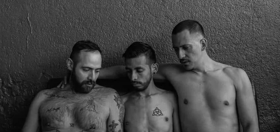
Late queer activist Marsha P. Johnson has become immortalized for her iconoclasm and style, but it seems that only a few surviving insiders can describe what Marsha was actually like on an intimate level. Well, in a book called Transfigures — and a new play — author Gary LeGault does just that.
LeGault says Johnson was religious and polite and hardly ever drank or cursed. He remembers letting Marsha stay over in his apartment when she needed a place and says she was always respectful and let herself out in the morning, conscientiously locking the door behind her as she left. When Johnson hit the bars, she would only have one beer and then go back to Christopher Street, where she panhandled. (She was also a sex worker and performer.) Marsha was happy that Andy Warhol did a portrait of her, but she was less entranced by his world than by artistry that appealed to her personal taste. She loved jazz divas Billie Holiday and Dinah Washington and the camp film What Ever Happened To Baby Jane?
Related: 32 of the best LGBTQ+ books to read yourself or gift others
Johnson had a younger boyfriend named Joseph, and they enjoyed going out and causing a stir, though Joseph couldn’t seem to understand why they couldn’t be accepted as an ordinary couple by society. Her demeanor was clearly mysterious to some while utterly engaging to others. Writes LeGault, “Marsha would speak in a faraway, otherworldly voice, as if she were not quite within the moment, then suddenly snap back into the situation with complete recognition.”
How about we take this to the next level?
Our newsletter is like a refreshing cocktail (or mocktail) of LGBTQ+ entertainment and pop culture, served up with a side of eye-candy.
Johnson grappled with mental health issues and would sometimes press a lit cigarette into her upper thigh, aware that it wasn’t exactly healthy behavior. What’s more, she always felt pain when she walked, since a cab driver had shot her in the butt when she ran out of the vehicle (no doubt to avoid paying), and the bullet was too close to the spine to be removed by surgeons. So they just left it there!
Another late drag icon, Warhol superstar Holly Woodlawn, is quoted in LeGault’s book as saying, “Marsha and I threw beer cans at the police together during the Stonewall riot. But at that time, no one thought of her as anything but a street person.”
She became increasingly iconic to the queer community, but LeGault claims that Johnson was a little fed up with living toward the end of her life. Her remains were found in the Hudson River in 1992, and LeGault doesn’t know if that was the result of suicide or murder (though other key people are convinced it couldn’t have been suicide). “But one thing is certain,” says LeGault. “Marsha was weary. Marsha was in pain.”
LeGault’s related play with music, Joseph and Marsha, is playing at Theater for the New City in New York City’s East Village through February 12. It’s a lovely, heartfelt and knowing musical, with a letter perfect Bryce Payne as Marsha; in fact, the entire cast is terrific. LeGault describes it as “a strange cross between Oliver! and West Side Story.” I guess that makes sense since those shows brought us “Where is Love?” and “There’s a place for us…”
Getting stoned at Stonewall

The aforementioned Stonewall Inn has been through a significant change, according to actor/singer Tym Moss. As Moss just told me, “The main floor is practically all straight now because the landmarked place has gotten more and more publicity. The heterosexuals have heard about it, and they basically want to come and observe the gays. One night not long ago, I was there with a guy I’ve been dating, and we were talking and making out. This straight woman was excited to see us because we were among the few gays there. She came up to me and said, ‘Hi! I have a shot for you!’ and she sweetly handed me a glass of booze. It was like feeding the animals at the zoo,” he added, erupting into raucous laughter. Amazing. When word of this gets out, the gays might return to Stonewall.
Putting the “thesis” back in prosthesis

I’ll gladly pour champagne for Oscar front-runner Brendan Fraser, who gives a beautiful performance in The Whale as a plus-sized bisexual writing teacher who seems to be eating himself to death but who wants to make amends with his estranged daughter before he goes. Fraser brings tremendous empathy to the character, a truth seeker who has made some missteps but has also been served hard luck and is desperate to ignite positivity in his final moments.
At a reception for the film at the Roxy Hotel, I asked Fraser if he’s gotten a good response from the queer community, and he said yes, people have been supportive because the film tells a meaningful story. When I asked about the “fat suit” he wears, the actor wisely responded, “You’ll never hear me refer to the costume that way.” He said his appearance in the film is thanks to prosthetic makeup designer Adrien Morot, who also happens to be the animatronic character designer for M3GAN. The man’s clearly a genius! So is Fraser, but when I asked what else he’s working on, he laughed and said, “Looking for a job, I guess.” But naturally, he’s Cliff Steele on Doom Patrol, and he will also be working the room on Oscar night.
This article includes links that may result in a small affiliate share for purchased products, which helps support independent LGBTQ+ media.



















Kangol2
Great commentary by Michael Musto, as always. The sidewalk outside the Stonewall Inn is probably more of a gay site than inside its doors, but it’s still a fun place to drop into. I’d say beware of accepting any drinks from anybody, though, given the ongoing drugging, robbing and, in several cases, murderous incidents that are occurring in New York. Perhaps Queerty also will report on the recent incidents at the New York Eagle. Don’t touch that drink unless you see the bartender prepare it for you and by all means, don’t leave it and look or walk away, especially if you’re not with an observant friend.
LumpyPillows
Good advice. I know one of the fellows who was drugged, robbed and killed. Best not to go out alone either. Sad to say.
LumpyPillows
Nice to know!
LumpyPillows
The story about Marsha seems mostly correct, but it does seem to be trying to whitewash her personality. I’ve been under the strong impression from other accounts that Marsha was a party creature and was a big drinker. Larger than life, for sure.
inbama
At least he didn’t turn her into the person who threw the first brick and started the riot.
NYCNative
Marsha was a friend of mine for many years. When I knew her (the last 10 years of her life), she was not (much of) a drinker at all. She was wonderfully colorful without alcohol and would regale people with stories that were brilliantly creative. One of my faves always ended in her exclaiming, “…more lime jello, Jeff Stryker!”
LumpyPillows
Posted in the wrong place! Nice to know!
dbmcvey
She was very politically active, she and Sylvia Rivera formed the group Street Transvestite Action Revolutionaries to help the kids on the street.
DCFarmboy
Jeez, Andy Warhol and Marsha Johnson both practicing Catholics. They are all over the place.
still_onthemark
What did the P. stand for?
Ronbo
Marsha, Musto and George Santos are reported to be the original trilogy that sparked our movement for equality. That’s the printed bio in black and white – and we KNOW that publicists, writers, gossip columnists and congresscritters would never stretch the truth – not even a tiny bit. Not for a book and not for a hook, not even for cash for a crook.
bachy
The Stonewall account shines a light on the wholesale acceptance of “visibility” as an unquestioned value.
dbmcvey
So, you don’t think it’s good?
SDR94103
the drag community is pushing for her to be recognized for something she was barely part of. Watch newsreels from that period, you never see her or hardly any POC demonstrating.
LumpyPillows
But that does not fit with the new, revised history that devalues CIS, white, gay men as oppressors!
dbmcvey
She continued her activism after Stonewall.
LumpyPillows
My understanding is Marsha was very unreliable and his leadership is wildly overrated. Marsha was also a gay male transvestite. His own words.
UlfRaynor
Precisely. Every single year for the last 4, Queerty has pushed the narrative that Johnson and Rivera almost single handedly started the Stonewall riots, while never once in that same time period try interviewing a single person still living who were there at the time.
I find it interesting that Holly Woodlawn said she and Johnson threw beer cans at the police during the riot, but Johnson himself stated repeatedly that he wasn’t there until it was almost over.
Fred Sargeant, who was among five gay men still living that were at the Inn that night, stated that Johnson was no where to be seen during the riots; which coincides with what Johnson himself has said on numerous occasions.
I think it’s damn near unforgivable that not one single gay news site ever reaches out to the last surviving members of the riots and interview them…oh, I forgot, a 74 year old Fred Sargeant was physically assaulted by trans activist at Pride last year because he was holding a sign that stated: “GAY, NOT QUEER”
For this horrific offense, he was slapped, shoved, had hot coffee thrown on him, spat upon, had his sign ripped from his hands and torn up, had some personal property stolen and was ultimately knocked forcibly to the ground all while the police did nothing.
For those who don’t know, Fred was one of five gay men who began the gay liberation movement after Stonewall and the one who organized and planned the very first pride march.
The so called writers at Queerty sicken me with their pandering sycophancy and their complete contemptable disregard for the truth.
Never fear though, I’ll be here to rub your collective noses in the glitter covered turd you pass off as news.
Ronbo
Hopefully, everyone knows that Queerty has an agenda and it’s often not the truth. Editor and profiteer, Graham Gremore posted multiple false anti-gay stories personally attacking out, successful, gay man, Alex Morse to help a much more conservative “power player” remain in office.
Alex Morse’s political career was killed and FOX News was jumping for joy when Graham falsely reported that Morse was a sexual predator attacking innocent youth. HOW is that “Free of an agenda (except that gay one)”!?!